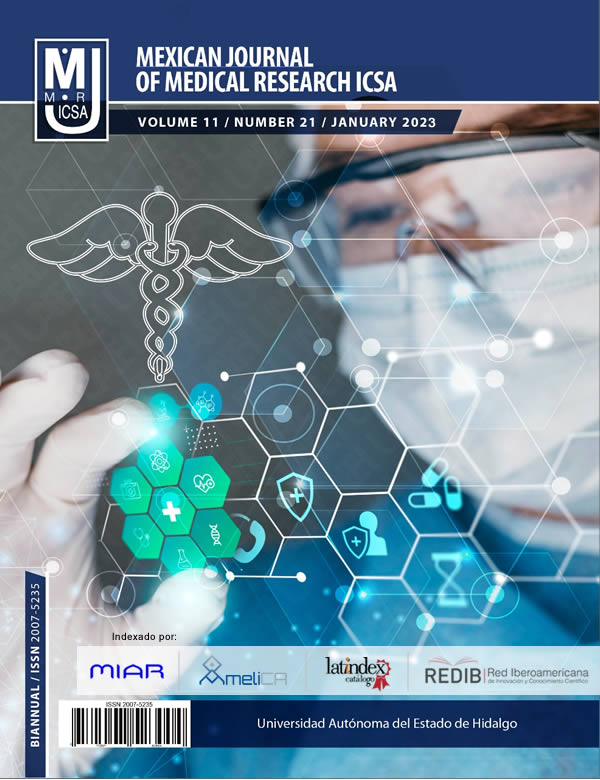Indole as a regulator of bacterial physiology
DOI:
https://doi.org/10.29057/mjmr.v11i21.8894Keywords:
tryptophanase, bacteria, e. coli, indole, regulator, signallingAbstract
During the last years, indole has been the subject of study, this is chemically defined as an aromatic bicyclic heterocycle, from the synthesis of tryptophan after its degradation by tryptophanase (TnaA); in turn has been implicated as a signalling molecule used by several bacteria to establish multiple behaviours. Most studies have focused mainly on Escherichia coli (E. coli), which produces a small amount of indole during the transition from exponential to stationary phase. According to the literature review, indole plays a fundamental role in many bacterial processes, mainly: biofilm formation, virulence, acid resistance, antibiotic resistance and persistent cell formation; the concentrations of this molecule play an important role in regulating these mechanisms; on this basis, indole could control undesired bacterial physiological processes, offering us a new therapeutic alternative to different behaviours of microorganisms. The objective of this bibliographic review is to expand the area of knowledge about indole as a regulator of diverse bacterial mechanisms, and thus motivate further research on this molecule and its therapeutic use.
Downloads
Publication Facts
Reviewer profiles N/A
Author statements
- Academic society
- N/A
- Publisher
- Universidad Autónoma del Estado de Hidalgo
References
Wang T, Zheng X, Ji H, Wang TL, Xing XH, Zhang C. Dynamics of transcription–translation coordination tune bacterial indole signaling. Nat. Chem. Biol. 2020;16(4):440-9.
Gaimster H, Summers D. Regulation of Indole Signalling during the Transition of E. coli from Exponential to Stationary Phase. PloS. One. 2015;10(9): e0136691.
Lee J-H, Lee J. Indole as an intercellular signal in microbial communities. FEMS. Microbiol. Rev. 2010;34(4):426-44.
Bejarano Triana JA. Synthesis of compounds with indole and pyridinic nucleus and evaluation of their cytotoxic activity. [Degree magister thesis]. Bogotá: Pontifica Javeriana University; 2015.
Melander RJ, Minvielle MJ, Melander C. Controlling bacterial behavior with indole-containing natural products and derivatives. Tetrahedron. 2014;70(37):6363-72.
Kim J, Park W. Indole: a signaling molecule or a mere metabolic byproduct that alters bacterial physiology at a high concentration? J. Microbiol. Seoul. Korea. 2015;53(7):421-8.
Wang D, Ding X, Rather PN. Indole Can Act as an Extracellular Signal in Escherichia coli. J. Bacteriol. 2001;183(14):4210-6.
Kumar A, Sperandio V. Indole Signaling at the Host-Microbiota-Pathogen Interface. mBio. 2019;10(3): e01031-19.
Gaimster H, Cama J, Hernández-Ainsa S, Keyser UF, Summers DK. The indole pulse: a new perspective on indole signalling in Escherichia coli. PloS. One. 2014;9(4): e93168.
Kim Y-G, Lee J-H, Cho MH, Lee J. Indole and 3-indolylacetonitrile inhibit spore maturation in Paenibacillus alvei. BMC. Microbiol. 2011; 11:119.
Parra Flores DC. Analysis of indole function as a quorum sensing signal and indicator of the metabolic state of Escherichia coli bacteria. [Degree project]. Bogotá: University of the Andes; 2010.
Kim J, Hong H, Heo A, Park W. Indole toxicity involves the inhibition of adenosine triphosphate production and protein folding in Pseudomonas putida. FEMS. Microbiol. 2013;343(1):89-99.
Zarkan A, Matuszewska M, Trigg SB, Zhang M, Belgami D, Croft C, et al. Inhibition of indole production increases the activity of quinolone antibiotics against E. coli persisters. Sci. Rep. 2020;10(1):11742.
Rabin N, Zheng Y, Opoku-Temeng C, Du Y, Bonsu E, Sintim HO. Biofilm formation mechanisms and targets for developing antibiofilm agents. Future. Med. Chem. 2015;7(4):493-512.
Lee J, Jayaraman A, Wood TK. Indole is an inter-species biofilm signal mediated by SdiA. BMC. Microbiol. 2007; 7:42.
Chant EL, Summers DK. Indole signalling contributes to the stable maintenance of Escherichia coli multicopy plasmids. Mol. Microbiol. 2007;63(1):35-43.
Chimerel C, Field CM, Piñero-Fernandez S, Keyser UF, Summers DK. Indole prevents Escherichia coli cell division by modulating membrane potential. Biochim. Biophys. Acta. 2012;1818(7):1590-4.
Howard MF, Bina XR, Bina JE. Indole Inhibits ToxR Regulon Expression in Vibrio cholerae. Infect. Immun. 2019;87(3): e00776-18.
Rattanaphan P, Mittraparp-Arthorn P, Srinoun K, Vuddhakul V, Tansila N. Indole signaling decreases biofilm formation and related virulence of Listeria monocytogenes. FEMS. Microbiol. 2020;367(14): fnaa116.
Alexeev EE, Lanis JM, Kao DJ, Campbell EL, Kelly CJ, Battista KD, et al. Microbiota-Derived Indole Metabolites Promote Human and Murine Intestinal Homeostasis through Regulation of Interleukin-10 Receptor. Am. J. Pathol. 2018;188(5):1183-94.
Lee HH, Molla MN, Cantor CR, Collins JJ. Bacterial charity work leads to population-wide resistance. Nature. 2010;467(7311):82-5.
Kim CS, Li J-H, Barco B, Park HB, Gatsios A, Damania A, et al. Cellular Stress Upregulates Indole Signaling Metabolites in Escherichia coli. Cell. Chem. Biol. 2020;27(6):698-707.e7.
Vega NM, Allison KR, Khalil AS, Collins JJ. Signaling-mediated bacterial persister formation. Nat. Chem. Biol. 2012;8(5):431-3.






















